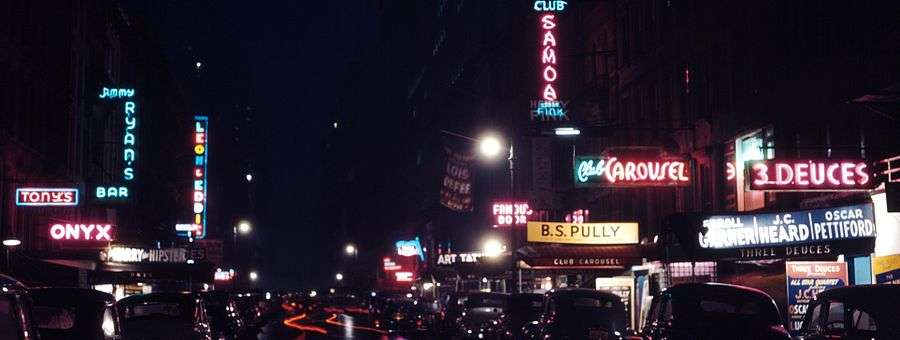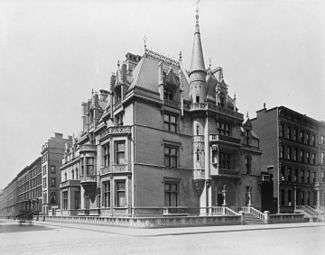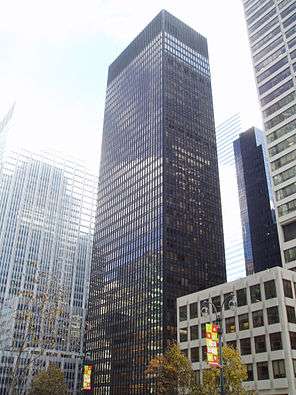52nd Street (Manhattan)
Coordinates: 40°45′25″N 73°58′11″W / 40.757076°N 73.969857°W
|
The theatres of 52nd Street in 2007 | |
| Maintained by | City of New York |
|---|---|
| Length | 1.9 mi (3.1 km) |
| Location | New York |
| West end |
|
| East end | Cul-de-sac a block east of First Avenue |
52nd Street is a 1.9-mile (3.1 km) long one-way street traveling west to east across Midtown Manhattan, New York City. It was known as the city's center of jazz performance from the 1930s to the 1950s.
Jazz center

Following the repeal of Prohibition in 1933, 52nd Street replaced 133rd street as "Swing Street" of the city. The blocks of 52nd Street between Fifth Avenue and Seventh Avenue became renowned for the abundance of jazz clubs and lively street life. The street was convenient to musicians playing on Broadway and the 'legitimate' nightclubs and was also the site of a CBS studio. Musicians who played for others in the early evening played for themselves on 52nd Street.
In its heyday from 1930 through the early 1950s, 52nd Street clubs hosted such jazz legends as Miles Davis, Harry Gibson, Dizzy Gillespie, Billie Holiday, Nat Jaffe, Marian McPartland, Thelonious Monk, Charlie Parker, Louis Prima, Art Tatum, Fats Waller, Trummy Young, and many more. Although musicians from all schools performed there, after Minton's Playhouse in uptown Harlem, 52nd Street was the second most important place for the dissemination of bebop;.[1] In fact, a tune called "52nd Street Theme" by Thelonious Monk became a bebop anthem and jazz standard.

Virtually every great jazz player and singer of the era performed at clubs:
52nd, between 6th & 7th[2]
- Kelly's Stable, 137 W 52
- The Hickory House, 144 W 52
52nd, between 5th & 6th
- 21 Club, 21 W 52
- Leon & Eddie's, 33 W 52
- The Famous Door
- 35 W 52 (Mar 1935–May 1936)
- 66 W 52 (Dec 1937–Nov 1943)
- 201 W 52 (Nov 1943–1944)
- 56 W 52 (1947–1950)
- Jimmy Ryan's, 53 W 52 (1934–1962)
- 154 W 54th (1962–1983)
- Spotlight Club, 56 W 52
- Club Samoa
- 62 W 52 (1940–1943)
- became a strip club in 1943
- 35 W 52 (1927–1933) (owned by Joe Helbock)
- 72 W 52 (1933–1937) (owned by Joe Helbock)
- 62 W 52 (1937–1939) (owned by Joe Helbock, et al.)
- 57 W 52 (1942–1949) (unrelated to the original Onyx)
- became a strip club in 1949
- Yacht Club, 66 W 52
- Club Downbeat, 66 W 52
- Club Carousel, 66 W 52
- 3 Deuces, 72 W 52
Noted jazz disc jockey Symphony Sid frequently did live broadcasts from the street, making it well-known across the country.
By the late 1940s the jazz scene began moving elsewhere around the city and urban renewal began to take hold of the street. By the 1960s, most of the legendary clubs were razed or fell into disrepair. The last club there closed its doors in 1968. Today, the street is full of banks, shops, and department stores and shows little trace of its jazz history. The block from 5th to 6th Avenues is formally co-named "Swing Street" and one block west is called "W. C. Handys Place".
The 21 Club is the sole surviving club on 52nd Street that also existed during the 1940s. The venue for the original Birdland at 1674 Broadway (between 52nd & 53rd), which came into existence in 1949, is now a "gentlemen's club." The current Birdland is on 44th Street, between 8th and 9th Avenues.
Notable places along 52nd Street
This is a list of notable places within one block of 52nd Street.
West Side Highway
- The route begins at the West Side Highway (New York Route 9A). Opposite the intersection is the New York Passenger Ship Terminal and the Hudson River
- Hustler Club on south side
- De Witt Clinton Park on north (the whole west side neighborhood of Clinton derives its name from the park
- Studios of The Daily Show broadcast (south)
Eleventh Avenue
The section between Eleventh and Tenth Avenues is signed "Joe Hovarth Way" in tribute to Joseph Hovarth (1945–1995) who located the Police Athletic League William J. Duncan Center on the block after moving from its original location.[3] The Duncan Center is named for a patrolman who was shot while chasing a stolen car in the neighborhood on May 17, 1930.[4]
Tenth Avenue
- Closed Midtown Branch of Saint Vincent's Catholic Medical Center (formerly St. Clares Hospital) (south)
Ninth Avenue
- The Manhattan School – Public School 35, special ed. (317 Wt 52nd) (north)
- Radio City Station Post Office (zip code 10019) (south)
- The Link (south), 43–story, 215–unit, glass tower condominium (height = 471 feet), opened in 2007[5] on site of the S.I.R. (Studio Instrument Rentals, Inc.) building at 310 W 52nd, known as the Palm Gardens Building.[6] S.I.R. occupied the building from 1974 until 2004. Cheetah, the well-known club that had once been at 53rd and Broadway, occupied the Palm Gardens building from 1968 to 1974. Cheetah became a popular Latin-American dance club that helped popularize Salsa to mainstream America.[7]
Eighth Avenue
- Neil Simon Theatre (south)
- August Wilson Theatre (north)
- Gallagher's Steak House (south)
- Novotel 26 floor 83 m 272 ft (83 m) hotel opened in 1984[8] (south)
- 1675 Broadway - 35-floor 148 m 485 ft (148 m) office building opened in 1990[9] (north)



Broadway
- Sheraton Manhattan Hotel at Times Square, 22-story 69 m 225 ft (69 m) opened in 1962[10] (south)
Seventh Avenue
- Seventh to Sixth is signed W.C. Handy's Place
- AXA Center, 54-floor 229 m 752 ft (229 m) office tower opened in 1986[11] (south)
- Sheraton New York Hotel & Towers, 51-story 153 m 501 ft (153 m) opened in 1962[12] (north)
- Flatotel New York City, 46-floor 145 m 475 ft (145 m) Flatotel that opened in 1992 and is the street's(north)[13]
- Credit Lyonnais Building 45-floor 186 m 609 ft (186 m) office building that opened in 1964 (north)
- 1285 Avenue of the Americas, 42-story 166 m 545 ft (166 m) office building[14] (south)
Sixth and a Half Avenue
- In the middle of block between Sixth and Seventh Avenues is a pedestrian corridor named by the city "Sixth and a Half Avenue", which runs from 51st to 57th Streets.[15]
Sixth Avenue
- Sixth Avenue to Fifth Avenue is signed "Swing Street"
- AXA Financial Center 43-story 174 m 571 ft (174 m) completed in 1963.[16] It has a large Thomas Hart Benton mural in lobby. (south)
- CBS Building, headquarters of the network and popularly referred to as "Black Rock" (north)
- 31 West 52nd Street 30-floor 125 m 411 ft (125 m) completed in 1986 originally for the E.F. Hutton headquarters. Currently the New York office of the international law firm, Clifford Chance (north) and the New York office of investment bank TD Securities.
- Paley Center for the Media (north)
- 75 Rockefeller Center, 33 129 m 424 ft (129 m) building completed in 1947 the last of the original Rockefeller Center buildings that was originally used for the headquarters of the Rockefeller Esso Oil Company[17] (north)
- 21 Club (north)
- 666 Fifth Avenue (north)
- 650 Fifth Avenue (south) 36-story, 150 m 492 ft (150 m) office tower completed in 1978[18]
Fifth Avenue
- The Street between Fifth and Madison is signed "Place de Cartier" because of the Cartier SA store at Fifth Avenue (south)
- Olympic Tower (south)
- Austrian Cultural Forum Building for Austria[19]
- Omni Berkshire Place Hotel[20]
- Hanover Bank Building 30-story, 119 m 389 ft (119 m) completed in 1962
Madison Avenue
- Park Avenue Plaza Building, 45 story 175 m 574 ft (175 m) building completed in 1981 above the Racquet and Tennis Club (north)[21]
Park Avenue
- Seagram Building, 38-floor 157 m 515 ft (157 m) building completed in 1958 that is home to the Four Seasons Restaurant[22]
- 345 Park Avenue, 44-story 193 m 634 ft (193 m) building completed in 1969 (south)
Lexington Avenue
- 52nd between Lexington and Third Avenue is signed Israel Bonds Way (the Development Corporation for Israel which issues the bonds is headquartered at the intersection in the Grolier Building).
- Grolier Building 33-story 126 m 414 ft (126 m) building completed in 1958[23]
- 599 Lexington Avenue, 50-story 199 m 653 ft (199 m) building completed in 1986 (north)[24]
- 150 East 52nd Street, 35-story 119 m 390 ft (120 m) building completed in 1983[25]
Third Avenue
- 875 3rd Avenue 29-story 122 m 399 ft (122 m) building completed in 1983[26] (north)
- MacMillan Building 31-story 111 m 364 ft (111 m) building completed in 1966[27]
- Hungary Consulate
- Zambia Mission to the United Nations
Second Avenue
- Thailand Consulate and Mission to the United Nations
First Avenue
- 52nd Street is two-way traffic east of First Avenue since it dead ends on a bluff above the FDR Drive.
- Southgate Apartment
- Rivergate Apartment
- 450 East 52nd - "The Campanile" is a 14-story brick cooperative apartment building overlooking the East River. It was home to celebrities such as Greta Garbo and John Lennon.
References
Notes
- ↑ Miles Davis (1989) Autobiography
- ↑ Ken Vail, Jazz milestones: a pictorial chronicle of jazz 1900-1990, Volume, Part 2, Castle Communications (1993) OCLC 30781182, 34905815, 680173922 ISBN 095222870X ISBN 9780952228707 ISBN 1860740502 ISBN 9781860740503
- ↑ MAYOR GIULIANI CONSIDERS LEGISLATION TO CREATE "JOE HORVATH STREET" IN MANHATTAN - nyc.gov - May 30, 1997
- ↑ P.A.L. DEDICATES ITS DREAM HOUSE; New Center on West Side Created From Building Abandoned by Y.W.C.A - New York Times - January 22, 1956
- ↑ The Link, New York City / Emporis.com
- ↑ Christopher Walsh, S.I.R. on the Move, Billboard Magazine, July 10, 2004, pg. 56
- ↑ Larry Rohter, It Happened One Night at the Cheetah, The New York Times, August 19, 2011
- ↑ Accor Novotel, New York City / Emporis.com
- ↑ 1675 Broadway, New York City / Emporis.com
- ↑ Sheraton New York hotel & Towers Emporis.com
- ↑ AXA Center, New York City / Emporis.com
- ↑ Sheraton City Squire Hotel, New York City / Emporis.com
- ↑ Flatotel New York City, New York City / Emporis.com
- ↑ 1285 Avenue of the Americas, New York City / Emporis.com
- ↑ Officially Marking a New Manhattan Avenue, NYTimes - City Room, July 13, 2012 - accessed July 31, 2012
- ↑ 1290 Avenue of the Americas, New York City / Emporis.com
- ↑ Time-Warner Building, New York City / Emporis.com
- ↑ 650 Fifth Avenue, New York City / Emporis.com
- ↑ Austrian Cultural Institute Building, New York City / Emporis.com
- ↑ Omni Berkshire Place Hotel, New York City / Emporis.com
- ↑ Park Avenue Plaza Building, New York City / Emporis.com
- ↑ Seagram Building, New York City / Emporis.com
- ↑ Grolier Building, New York City / Emporis.com
- ↑ 599 Lexington Avenue, New York City / Emporis.com
- ↑ 150 East 52nd Street, New York City / Emporis.com
- ↑ 875 3rd Avenue, New York City / Emporis.com
- ↑ MacMillan Building, New York City / Emporis.com
External links
| Wikimedia Commons has media related to 52nd Street (Manhattan). |
- 52nd Street: A New York Songline - virtual walking tour
